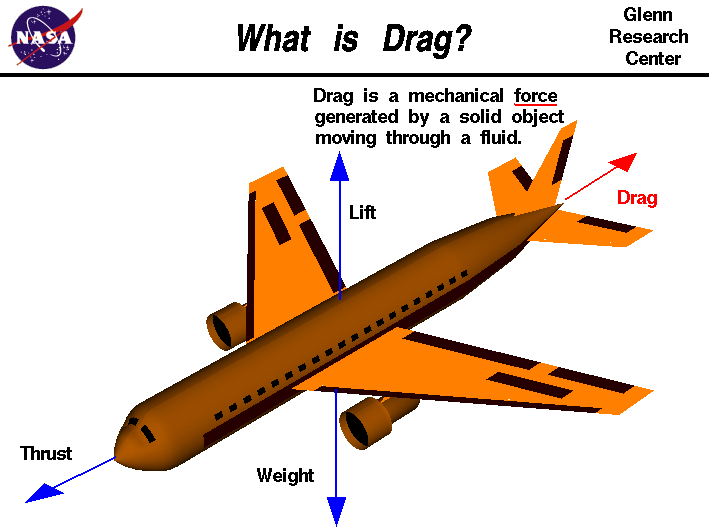
Drag is the aerodynamic force that
opposes an aircraft's motion through the air. Drag is generated by
every part of the airplane (even the engines!).
How is drag generated?
Drag is a mechanical force. It is generated by the interaction and
contact of a solid body with a fluid (liquid or gas). It is
not generated by a force field, in the sense of a gravitational
field or an electromagnetic field, where one object can affect
another object without being in physical contact. For drag to be
generated, the solid body must be in contact with the fluid. If there
is no fluid, there is no drag. Drag is generated by the
difference in velocity
between the solid object and the fluid. There must be motion
between the object and the fluid. If there is no motion, there is no
drag. It makes no difference whether the object moves through a
static fluid or whether the fluid moves past a static solid object.
Drag is a force and is therefore a
vector quantity
having both a magnitude and a direction.
Drag acts in a direction that is opposite to the motion
of the aircraft. Lift acts perpendicular to the motion.
There are many
factors
that affect the magnitude of the drag.
Many of the factors also affect lift
but there are some factors that are unique to aircraft drag.
We can think of drag as aerodynamic friction, and one of
the sources of drag is the skin friction between the molecules
of the air and the solid surface of the aircraft. Because the skin
friction is an interaction between a solid and a gas, the magnitude
of the skin friction depends on properties of both solid and gas. For
the solid, a smooth, waxed surface produces less skin friction than a
roughened surface. For the gas, the magnitude depends on the
viscosity of the air and the relative
magnitude of the viscous forces to the motion of the flow, expressed
as the Reynolds number. Along the solid surface, a
boundary layer
of low energy flow is generated and the magnitude of the
skin friction depends on conditions in the boundary layer.
We can also think of drag as aerodynamic resistance to the
motion of the object through the fluid. This source of drag depends
on the
shape
of the aircraft and is called form drag. As air
flows around a body, the local velocity and pressure
are changed. Since pressure is a measure of the momentum of the gas
molecules and a change in momentum produces a force,
a varying pressure distribution will produce a force on the body. We
can determine the magnitude of the force by
integrating (or adding up) the local pressure times the surface area
around the entire body. The component of the aerodynamic force that
is opposed to the motion is the drag; the component perpendicular to
the motion is the lift.
Both the lift and drag force act through the
center of pressure
of the object.
There is an additional drag component caused by the generation of
lift. Aerodynamicists have named this component the
induced drag.
This drag occurs because the flow near the wing tips is
distorted spanwise as a result of the pressure difference from the
top to the bottom of the wing. Swirling vortices are formed at the
wing tips, which produce a
down wash
of air behind the wing which is very strong near the wing tips and
decreases toward the wing root. The local
angle of attack
of the wing is increased by the induced flow of the down wash,
giving an additional, downstream-facing, component to the
aerodynamic force acting over the entire wing.
This additional force is called induced drag because it
has been "induced" by the action of the tip vortices.
It is also called "drag due to lift" because it only occurs
on finite, lifting wings.
The magnitude of induced drag depends on the amount of lift
being generated by the wing and on the wing
geometry. Long, thin (chordwise) wings have low induced drag;
short wings with a large chord have high induced drag.
Additional sources of drag include wave drag and ram drag. As an
aircraft approaches the speed of sound,
shock waves
are generated
along the surface. There is an additional drag penalty (called
wave drag) that is associated with the formation of the shock
waves. The magnitude of the wave drag depends on the Mach
number of the flow. Ram drag is associated with slowing
down the free stream air as air is brought inside the aircraft. Jet
engines and cooling inlets on the aircraft
are sources of ram drag.
You can view a short
movie
of "Orville and Wilbur Wright" discussing the drag force
and how it affected the flight of their aircraft. The movie file can
be saved to your computer and viewed as a Podcast on your podcast player.
Activities:









Guided Tours
-
 Sources of Drag:
Sources of Drag:

-
 Factors that Affect Drag:
Factors that Affect Drag:

-
 Forces on an Airplane:
Forces on an Airplane:

-
 Forces on a Glider:
Forces on a Glider:

Navigation ..

- Beginner's Guide Home Page
|
